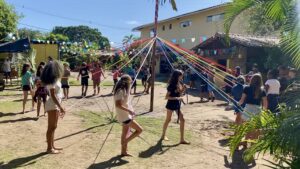The Differences Between Waldorf and Montessori Learning: A Brief Overview
Choosing the right educational approach for your child can be challenging. Among the most popular methods are Waldorf and Montessori. Each has distinct characteristics and aims to nurture children’s development in unique ways. Understanding their differences can help parents make informed decisions about their child’s education.

Alternative schooling exists worldwide, and I’ve had the privilege of visiting schools all over the globe to explore these unique educational philosophies. In this article, I’ll provide a brief overview of these two popular approaches to help you make an educated choice for your child’s future.
Core Philosophies
Waldorf Education
Waldorf education, founded by Rudolf Steiner in the early 20th century, emphasizes holistic learning. This approach integrates academic, artistic, and practical skills. Waldorf schools aim to foster intellectual, emotional, and spiritual growth. They engage students in a curriculum that evolves with their developmental stages.
Montessori Education
Dr. Maria Montessori developed the Montessori method. It focuses on child-centered learning and emphasizes independence, freedom within limits, and respect for a child’s natural development. Montessori classrooms promote self-directed activity, hands-on learning, and collaborative play. Children learn at their own pace.
Learning Environment
Waldorf
Waldorf classrooms are warm, inviting, and filled with natural materials. The environment includes art supplies, musical instruments, and tools for practical activities. Waldorf schools emphasize rhythm and routine, focusing on storytelling, arts, and crafts. Teachers guide students through a structured yet creative curriculum.
Montessori
Montessori environments are meticulously organized with various learning stations. These stations have specially designed educational materials that are self-correcting. This setup enables children to learn through trial and error. Montessori classrooms encourage free movement and independent choice, fostering responsibility and self-discipline.
Curriculum and Teaching Methods
Waldorf
The Waldorf curriculum aligns with the developmental stages of children. Early childhood education focuses on imaginative play, storytelling, and artistic activities. As students grow, the curriculum becomes more structured, including subjects like mathematics, science, literature, and history. Waldorf teachers often stay with the same group of students for several years, creating a stable learning environment.
Montessori
Montessori education emphasizes hands-on, experiential learning. The curriculum includes practical life skills, sensorial activities, language, mathematics, and cultural studies. Children learn through interacting with materials and are encouraged to explore subjects that interest them. Teachers act as facilitators, observing and guiding learning.
Assessment and Progression
Waldorf
Waldorf schools do not use traditional grades or standardized tests. Instead, teachers provide detailed narrative assessments of each student’s progress. These assessments focus on the child’s growth in various areas, including academic achievements, social skills, and personal development.
Montessori
Montessori education also avoids traditional grading. Progress is tracked through observation and detailed record-keeping. Teachers assess students based on their ability to master specific skills and concepts. Children move through the curriculum at their own pace, advancing as they demonstrate understanding.
Social and Emotional Development
Waldorf
Waldorf education emphasizes social and emotional development. The curriculum includes activities that promote empathy, cooperation, and community building. Artistic and practical activities, such as drama and gardening, help children develop emotional intelligence and interpersonal skills.
Montessori
Montessori education fosters social and emotional development through collaborative activities and mixed-age classrooms. Children learn from and with each other, developing leadership skills and a sense of community. The emphasis on independence and self-discipline also contributes to emotional resilience.
Conclusion
Both Waldorf and Montessori education offer unique benefits tailored to different aspects of child development. Waldorf education excels in nurturing creativity, imagination, and emotional growth. Montessori education promotes independence, self-discipline, and practical skills. Understanding these differences can help parents choose the best educational path for their child, aligning with their values and their child’s needs.

I recently visited a Waldorf school in Bahia, Brazil, where I had the opportunity to speak with teachers and explore the classrooms and school grounds. For more insights and details about this visit, keep an eye out for my upcoming post on social media.
🔴 Youtube
If you are interested in more resources for academic education and free resources for parents and students, keep reading below.

Alexandra Allover
International Academic Coach
Learn more about my travels here!
P.S.:
More support for students
If you are looking for more academic support, I can offer you access to the academic coaching course for students and teachers. Check out this offer for schools if you want to find out how to apply proven learning strategies, techniques to boost motivation and valuable test preparation skills.
Support for parents: Teens’ mental health
If you are looking for support regarding your child‘s mental health and want to improve your relationship with them, I want to suggest one of my free resources: the DIY Coaching Kit
By learning more about proven coaching strategies of the parent-child dynamics and the psychology behind it, you‘ll be able to act like a life coach for your own child without them even knowing 😉
✍️ Read more BLOG posts!

